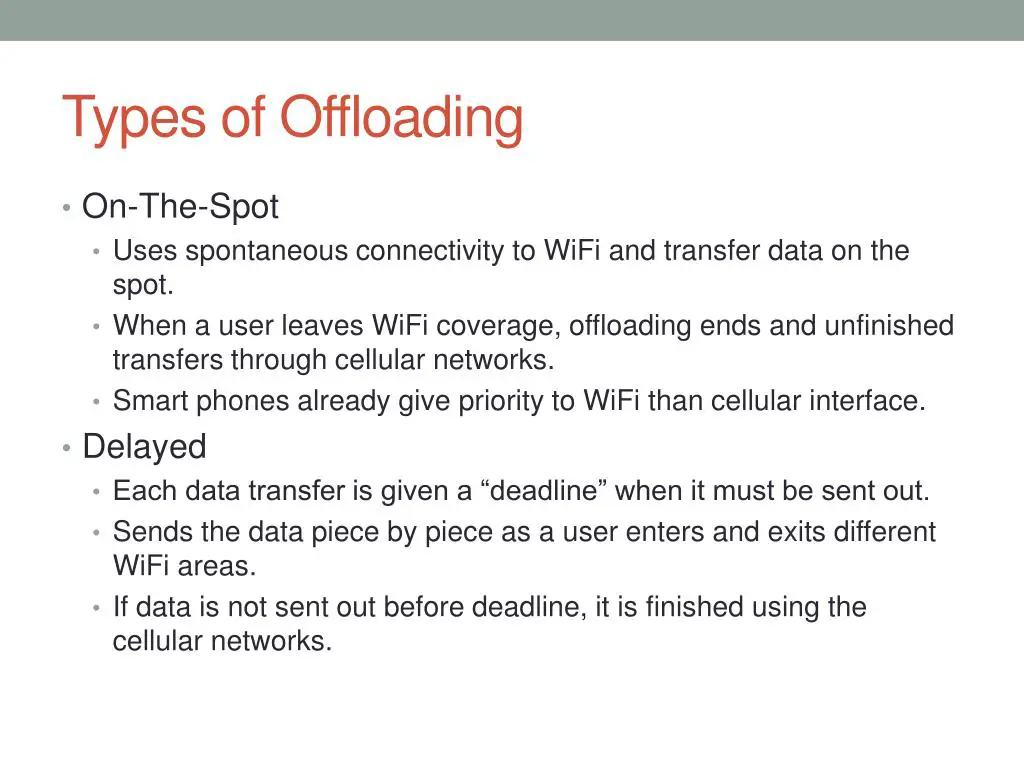Types Of Wi-Fi Offloading


Offloading seems to be the most viable solution at the moment. Building more Wi-Fi hotspots is significantly cheaper than network upgrades and build-outs. Many users are also installing their own Wi-Fi APs in homes and at work. If most data traffic is redirected through Wi-Fi networks, carriers can accommodate traffic growth at a lower cost. Given that there is already a wide-spread deployment of Wi-Fi networks, Wi-Fi offloading addresses the “time-to-capacity” problem currently requiring additional network capacity. There are two types of offloading: ● on-the-spot offloading, and ● delayed offloading. On-the-spot offloading is to use the seamless connectivity to Wi-Fi and transfer data on the spot; when users move out of Wi-Fi coverage, they turn off offloading and all unfinished transfers are transmitted through the cellular network. Most smart-phones that prioritize Wi-Fi over the cellular interface in data transmission can currently be expected to achieve on-the-spot offloading.
In delayed offloading, each data transfer is associated with a time limit and as users move in and out of Wi-Fi coverage areas, it repeatedly restarts the data transfer until the transfer is complete. If the data transfer does not finish within its time limit, the cellular networks finally complete the transfer. Most smart-phones with Wi-Fi are already doing on-the-spot offloading by default. But delayed offloading is relatively new.
There is no doubt that both on-the-spot and delayed offloading reduce the load on the mobile network. But an important, yet under-addressed question is how much benefit network providers and users can get. Network carriers are interested in knowing how much traffic load Wi-Fi offloading takes away from the cellular network under a given or future Wi Fi network deployment. Currently on-the-spot offloading is being offered through smart-phones. Since carriers do not have control over the Wi-Fi networks that users connect to, they have no idea of how much on-the-spot offloading helps them deliver now and in the future. How much does the new notion of delayed offloading help them reduce their traffic given the projected amount of data growth in the future? Answers to these questions can provide clues on their pricing and cost restructuring strategies.
The following factors drive the choice of Wi-Fi as an alternative technology for offloading cellular data traffic: ● Research shows that most of the internet data is consumed when the user is stationary (i.e. not mobile) e.g. within a building, home, office complex, mall etc. Thus, mobility is also not required. ● Nowadays, almost all smart devices come with Wi-Fi support. Hence, no additional cost is required from the customer perspective. ● Wi-Fi networks operate on unlicensed frequency bands and do not cause any interference with cellular networks. Wi-Fi is usually ubiquitously available in urban areas, either deployed by operators as commercial hotspots or deployed by users for residential use.
Thus, Wi-Fi becomes an obvious choice for network operators. It can help improve cellular coverage and increase capacity through spectrum reuse in areas where most of the data traffic is being generated e.g. in a building. Thus, cellular networks will be used for high QOS intensive traffic as well as mobility requirements e.g. VoIP, while Wi-Fi will be used for low QOS data traffic e.g. downloads, web surfing etc.
Read Also:
- Why Wi-Fi Offload
- Introduction About Wi-Fi Offloading
- Introduction To Wi-Fi
- Overview Of Wi-Fi Technology
- Wi-Fi And Hotspots: Emerging WLAN Technology In Indian Context
- Wi-Fi And Hotspots: Emerging WLAN Technology In Indian Context
- Development Of 5G Technology
- Introduction To Mobile Technology
Recent Posts
Elon Musk Launches Xchat With Disappearing Messages, Encrypted Chat, And More: Here’s How We Understand It
Elon Musk has launched Xchat, a new messaging app designed to provide users with a…
Alcatel V3 Series First Sale In India Today: Here’s How To Grab The Best Deals And Discounts On Smartphones
Alcatel V3 Classic 5G, V3 Pro 5G, and V3 Ultra 5G Go on First Sale…
Oppo K13 5G Smartphone
Golden Chance to Shop for Oppo's Oppo K13 5G Telecellsmartphone; Instant Financial Enterprises as low…
Itel Launched Alpha Pro Smartwatch
Itel has launched Alpha Pro smartwatch with powerful sports activities sports activities sports activities modes,…
How To Record Whatsapp Calls? Quickly Identify Its Smooth Way
How to record WhatsApp calls: WhatsApp does not have any built in recording function. This…
Reliance Power’s Share Rose 16% Today:₹ Reached A 52-Week High Of 60.50, In One Year The Company’s Share Returned 135%
Shares of Anil Ambani's company Reliance Power rose nearly 16% today (May 30) on Friday.…


